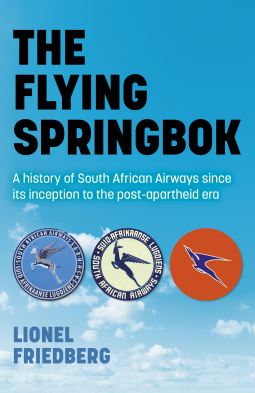
The Flying Springbok
A History of South African Airways Since Its Inception to the Post-Apartheid Era
by Lionel Friedberg
This title was previously available on NetGalley and is now archived.
Send NetGalley books directly to your Kindle or Kindle app
1
To read on a Kindle or Kindle app, please add kindle@netgalley.com as an approved email address to receive files in your Amazon account. Click here for step-by-step instructions.
2
Also find your Kindle email address within your Amazon account, and enter it here.
Pub Date Aug 01 2021 | Archive Date Jul 23 2021
John Hunt Publishing Ltd | https://www.johnhuntpublishing.com/chronos-books/
Talking about this book? Use #TheFlyingSpringbok #NetGalley. More hashtag tips!
Description
An artistic rendering of the African antelope, the Springbok, was depicted with stylized wings to serve as the logo of South African Airways (SAA) for well over 60 years. It was replaced by a new corporate identity when the airline was rebranded after the demise of apartheid, the release of Nelson Mandela from political incarceration, and the introduction of a non-racist democratic society in South Africa in the mid-nineties. As a state-owned entity, many people once saw SAA as the 'apartheid airline.' For a time, travel on board its aircraft was restricted to whites only, but this was later changed to include members of all the country's diverse racial groups.
SAA pioneered flight throughout Africa during the colonial era, long before airports, supply services, radio and weather forecasting capabilities even existed. Its staff and equipment served with the Allies in Europe and North Africa during WWII and it met the enormous challenge of having to circumvent African airspace when flying to destinations abroad after most African nations closed their skies to it in protest against the country's racist policies in the early sixties.
Over the years the airline grew into one of the world's major domestic, regional, and international carriers. Its long history was eventually terminated and replaced by a new entity in 2020 with the the outbreak of the coronavirus pandemic. In its original incarnation it could proudly boast of being one of the world's oldest and longest-surviving international carriers. It is still seen by many around the world as the airline with that much revered and fondly remembered emblem, the Flying Springbok.
A Note From the Publisher
Available Editions
| EDITION | Paperback |
| ISBN | 9781789046465 |
| PRICE | $35.95 (USD) |
Featured Reviews
So I am not who you would probably expect to be reading this book - a 60 year old female. I found this book fascinating. I was initially drawn to it because I flew a few times on SAA flights, London to Johannesburg, in the seventies on the Lebombo 747 and the Drakensburg.Not knowing Lebombo meant big nose as a child I thought it had something to do with a bomb, and so when one of the engines caught fire on takeoff from Heathrow I wasn’t surprised - though I was cheesed off that our holiday was delayed by a day whilst a new engine was flown out and fitted! These memories intrigued me to learn more about the airline in this book, but it was so much more. It is a history of aviation in South Africa, a history of the airline, but also a fascinating account of how the politics of the country shaped the airline and it routes. Also how the airline shaped the history of aviation around the world - I now know the reason for oval windows in aircraft!
I thought this book was wonderfully written - never dry, never boring. It was very informative, written with humour and great attention to detail. It is one of the few books I have reviewed that I will be buying on publication date. My thanks to Netgalley and the publisher for allowing me early access to. Digital copy of this book I return for an honest review.




